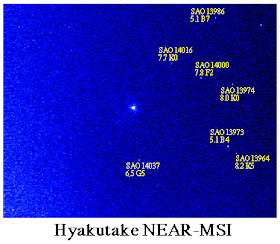On January 30, 1996, Comet Hyakutake was discovered using 25×150 binoculars. The comet was designated Comet C/1996 B2 (Hyakutake). As subsequent observations of the new comet were obtained, the IAU Central Bureau was able to compute the comet’s orbital elements, and these computations indicated that the comet passed as close as 0.10 AU from the Earth on March 25, 1996! The comet became a bright unaided-eye object and remained so in March, April and May in 1996. The comet had exceeded expectations, becoming the brightest comet since Comet West in 1976. A long tail of up to 100 degrees was reported, and small fragments have been observed to break off the main nucleus. Comet Hyakutake was indeed the Great Comet of 1996.
Comet Hyakutake led to several scientific discoveries. Most surprising to cometary scientists was the first discovery of X-rays being emitted from a comet. They are believed to have been caused by ionized solar wind particles interacting with neutral atoms in the coma of the comet. The Ulysses spacecraft unexpectedly crossed the comet’s tail at a distance of more than 500 million km from the nucleus, showing that Comet Hyakutake had the longest tail known for a comet. Hyakutake is a long period comet. Its orbital period was 17,000 years, but the gravitational influences of the large planets this trip through the inner solar system have extended that to every 100,000 years.
Comet Hyakutake became visible to the naked eye in early March 1996. By mid-March, the comet was still fairly unremarkable, shining at 4th magnitude with a tail about 5 degrees long. As it neared its closest approach to Earth, it rapidly became brighter, and its tail grew in length. After its close approach to the Earth, the comet faded to about 2nd magnitude. It reached perihelion on May 1, 1996, brightening again and exhibiting a dust tail in addition to the gas tail seen as it passed the Earth. By this time, however, it was close to the Sun and was not seen as easily. It was observed passing perihelion by the SOHO Sun-observing satellite, which also recorded a large coronal mass ejection being formed at the same time. Its distance from the Sun at perihelion was 0.23 AU, well inside the orbit of Mercury.


Hi! What's your point of view on who are your blog's common subscribers?
ReplyDelete